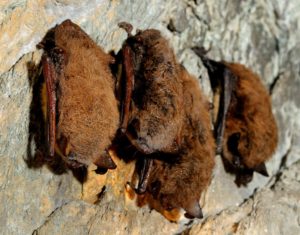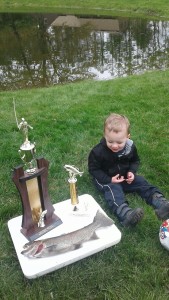Revival of a classic
If you are a baby boomer fisherman or older, you knew the name of the pictured lure. And if you are younger, chances are that when you saw that picture, you said,”Oh yes, I saw one of those in Dad’s (or Grandpa’s) old fishing tackle box”. If you didn’t cast that lure into our lakes and ponds in the 1950’s and 1960’s, and catch a lot of fish, something was wrong. Just mentioning that lure congers up warm and joyful memories alongside those who were most special to us – our parents or grandparents. The lure is the Al’s Goldfish.
Al’s Goldfish Company was founded by Al Stuart of Indian Orchard, Massachusetts. After World War II, Al returned home from military duty and started up a local sporting goods store. Soon thereafter, Al’s Goldfish appeared on the American fishing landscape. “There is uncertainty as to whether Stuart purchased the Al’s Goldfish from somebody or if he actually invented it himself” said John L. Occhialini, who later purchased the company. “ But he was the one that developed it for sure and he started producing it in the basement of his sporting goods store.” From 1953 through 1973, Al’s Goldfish sold nearly 1 million lures each year.
The original name for the lure was Stuart’s Goldfish but was renamed Al’s Goldfish in 1954. It was popular locally and it grew to the point where in 1954 he incorporated Al’s Goldfish Company. Stuart started out by stamping the lure out of brass but over time he refined and enhanced the finish using 22 karat gold. “He was actually ahead of his time in manufacturing production methods for the early 1950s,” said Occhialini. “He stamped out everything himself, did the plating and so forth.”
Stuart was also a devoted world traveler and in his travels he came up with many new ideas for his lures and he discovered ways to save money on manufacturing costs by purchasing hooks and materials overseas. Stuart was also ahead of his time as a savvy marketer and businessman. He cozied up to local media and sought out sports writers throughout the country, thus keeping Al’s Goldfish Company in the public’s eyes and ears.
“The big jump for the Al’s Goldfish was when he teamed up with Gadabout Gaddis in the early 1960s,” said Occhialini. “That’s when Al’s Goldfish really took off and really was one of the largest selling lures at that time.” The boomers remember Gadabout Gaddis (Roscoe Vernon) who was widely known as the pioneer of outdoor and fishing television. He inspired millions of Americans to venture out and enjoy the outdoors, to take up fishing and the cause of conservation. His TV show aired locally, right after the Friday Night Fights.
“Gadabout Gaddis actually sold a kit on his TV shows that was produced by Al’s Goldfish Company,” Occhialini explained. “And it included the Al’s Goldfish in it of course. As part of that arrangement, Gadabout Gaddis mentioned it on his TV show many times, and that’s when it really became a national seller. It soon became one of the best selling fishing lures in the country from the late 1950s through the 1970s. “It was one of the three biggest sellers in the 60s. According to the Stuarts, they were shipping out tractor trailer loads of them.
After Al Stuart passed away, his daughter inherited the business. With her husband, she ran the company for a number of years. In that time, the operation was downsized considerably, and many cost-conscious changes were made to the lures and the manufacturing processes. This unfortunately had a negative effect on the quality of the product and the prosperity of the company itself. By 1999, the advancing age of the owners and waning interest in the company led to their decision to retire and sell Al’s Goldfish Company, to Occhialini.
Upon acquiring the company, Occhialini revived the products, eliminating some of the cheaper, poor-selling plastic lures and concentrated on boosting the classic lineup of metal lures. He brought back the genuine 22 karat gold plating, which had been substituted with a cheaper alternative under the previous owners, in spite of the $300 an ounce cost of gold at the time.
Stamped and cast in marine brass, the lure is as durable today as it was over 50 years ago. “We were still using the same dies that Al Stuart used,” professed Occhialini. “So there hasn’t been a whole lot of change in fifty years. Once it is cast, the Goldfish is plated in shiny metallic finishes that include genuine gold, nickel, copper, reflective prism, and other colors. The lures have always been made In America. The blanks are made in Massachusetts, the paint is applied in Rhode Island, the split rings are made in Wisconsin, and the company headquarters is in Maine. All lures are hand-painted with hand-mixed color by Bob Christopher.
In 2006, Field and Stream magazine named Al’s Original Goldfish lure one of the “50 Greatest Lures of All Time.” In 2007, the lure made Field and Stream’s Top 10 Best Trout Lures of all time.
In May, 1966, Dana Deblois caught a 19 lbs 10 oz brown trout out of Wachusett Reservoir using the Al’s Goldfish 1/4 oz Gold Orange. It still remains the state record brown after all these years, making it the oldest Massachusetts state record catch.
Al’s Goldfish Company is now headquartered in Biddeford, Maine. The company was bought by Mike Lee in 2015 with a goal of continuing the American lure-manufacturing tradition.
Contact Information: Mike Lee, Al’s Goldfish Lure Company, Biddeford, Maine, mike@alsgoldfish.com, phone 413-543-1524.
Fishing Derby
The Berkshire Hatchery Foundation in Hartsville-New Marlborough is having a free children’s fishing derby next Saturday, July 8 from 9 to 10:30 AM at its lower pond. Children aged 12 and under must be accompanied by an adult.
Revival of a classic
If you are a baby boomer fisherman or older, you knew the name of the pictured lure. And if you are younger, chances are that when you saw that picture, you said,”Oh yes, I saw one of those in Dad’s (or Grandpa’s) old fishing tackle box”. If you didn’t cast that lure into our lakes and ponds in the 1950’s and 1960’s, and catch a lot of fish, something was wrong. Just mentioning that lure congers up warm and joyful memories alongside those who were most special to us – our parents or grandparents. The lure is the Al’s Goldfish.
Al’s Goldfish Company was founded by Al Stuart of Indian Orchard, Massachusetts. After World War II, Al returned home from military duty and started up a local sporting goods store. Soon thereafter, Al’s Goldfish appeared on the American fishing landscape. “There is uncertainty as to whether Stuart purchased the Al’s Goldfish from somebody or if he actually invented it himself” said John L. Occhialini, who later purchased the company. “ But he was the one that developed it for sure and he started producing it in the basement of his sporting goods store.” From 1953 through 1973, Al’s Goldfish sold nearly 1 million lures each year.
The original name for the lure was Stuart’s Goldfish but was renamed Al’s Goldfish in 1954. It was popular locally and it grew to the point where in 1954 he incorporated Al’s Goldfish Company. Stuart started out by stamping the lure out of brass but over time he refined and enhanced the finish using 22 karat gold. “He was actually ahead of his time in manufacturing production methods for the early 1950s,” said Occhialini. “He stamped out everything himself, did the plating and so forth.”
Stuart was also a devoted world traveler and in his travels he came up with many new ideas for his lures and he discovered ways to save money on manufacturing costs by purchasing hooks and materials overseas. Stuart was also ahead of his time as a savvy marketer and businessman. He cozied up to local media and sought out sports writers throughout the country, thus keeping Al’s Goldfish Company in the public’s eyes and ears.
“The big jump for the Al’s Goldfish was when he teamed up with Gadabout Gaddis in the early 1960s,” said Occhialini. “That’s when Al’s Goldfish really took off and really was one of the largest selling lures at that time.” The boomers remember Gadabout Gaddis (Roscoe Vernon) who was widely known as the pioneer of outdoor and fishing television. He inspired millions of Americans to venture out and enjoy the outdoors, to take up fishing and the cause of conservation. His TV show aired locally, right after the Friday Night Fights.
“Gadabout Gaddis actually sold a kit on his TV shows that was produced by Al’s Goldfish Company,” Occhialini explained. “And it included the Al’s Goldfish in it of course. As part of that arrangement, Gadabout Gaddis mentioned it on his TV show many times, and that’s when it really became a national seller. It soon became one of the best selling fishing lures in the country from the late 1950s through the 1970s. “It was one of the three biggest sellers in the 60s. According to the Stuarts, they were shipping out tractor trailer loads of them.
After Al Stuart passed away, his daughter inherited the business. With her husband, she ran the company for a number of years. In that time, the operation was downsized considerably, and many cost-conscious changes were made to the lures and the manufacturing processes. This unfortunately had a negative effect on the quality of the product and the prosperity of the company itself. By 1999, the advancing age of the owners and waning interest in the company led to their decision to retire and sell Al’s Goldfish Company, to Occhialini.
Upon acquiring the company, Occhialini revived the products, eliminating some of the cheaper, poor-selling plastic lures and concentrated on boosting the classic lineup of metal lures. He brought back the genuine 22 karat gold plating, which had been substituted with a cheaper alternative under the previous owners, in spite of the $300 an ounce cost of gold at the time.
Stamped and cast in marine brass, the lure is as durable today as it was over 50 years ago. “We were still using the same dies that Al Stuart used,” professed Occhialini. “So there hasn’t been a whole lot of change in fifty years. Once it is cast, the Goldfish is plated in shiny metallic finishes that include genuine gold, nickel, copper, reflective prism, and other colors. The lures have always been made In America. The blanks are made in Massachusetts, the paint is applied in Rhode Island, the split rings are made in Wisconsin, and the company headquarters is in Maine. All lures are hand-painted with hand-mixed color by Bob Christopher.
In 2006, Field and Stream magazine named Al’s Original Goldfish lure one of the “50 Greatest Lures of All Time.” In 2007, the lure made Field and Stream’s Top 10 Best Trout Lures of all time.
In May, 1966, Dana Deblois caught a 19 lbs 10 oz brown trout out of Wachusett Reservoir using the Al’s Goldfish 1/4 oz Gold Orange. It still remains the state record brown after all these years, making it the oldest Massachusetts state record catch.
Al’s Goldfish Company is now headquartered in Biddeford, Maine. The company was bought by Mike Lee in 2015 with a goal of continuing the American lure-manufacturing tradition.
Contact Information: Mike Lee, Al’s Goldfish Lure Company, Biddeford, Maine, mike@alsgoldfish.com, phone 413-543-1524.
Fishing Derby
The Berkshire Hatchery Foundation in Hartsville-New Marlborough is having a free children’s fishing derby next Saturday, July 8 from 9 to 10:30 AM at its lower pond. Children aged 12 and under must be accompanied by an adult.



![IMG_7999[1]](https://www.berkshireoutdoorsman.com/wp-content/uploads/2017/05/IMG_79991-228x300.jpg)